
The lunar month of Sawan, also known as Shravan or Sawan Mahina, maintains a unique position of veneration in the rich tapestry of Hindu culture. This blessed month, which usually falls in July or August, is devoted to Lord Shiva, one of the main deities in Hinduism. Religious beliefs, customs, and traditions that have been passed down through the years have a strong foundational influence on the significance of Sawan Mahina. In this blog, we’ll examine Sawan Mahina’s cultural significance for Hindus and dig into the customs and traditions that surround this auspicious month.

The Celestial Connection
The lunar month of Sawan, also known as Shravan or Sawan Mahina, possesses a celestial importance that resonates strongly with both the agricultural and spiritual facets of life in the rich tapestry of Hindu culture. The alignment of the planets and stars at this moment is a sign of heavenly benefits and rejuvenation more than just a celestial show.
When viewed from the celestial sphere, Sawan Mahina coincides peacefully with the appearance of the star “Shravan” in the night sky. The monsoon season in India, which is a crucial time for the agrarian landscape of the nation, officially begins with the occurrence of this astronomical event. The star “Shravan” is strongly linked to Lord Vishnu, a central figure in Hinduism, and is thought to represent the impending coming of rain, a necessary element for the region’s agricultural development.
In essence, Sawan Mahina serves as a profound reminder of the complex link between the celestial and terrestrial worlds in addition to being a time for religious rites and devotion. It teaches us to recognize the close connections between our spiritual path and the surrounding natural environment, as well as the divine design behind the cycles of nature. Similar to how showers relieve the earth’s needs, Sawan Mahina’s adoration and reverence feed the soul, fostering spiritual development. As a result, Sawan Mahina is a time to connect with God and receive the numerous gifts that come from both the heavenly and spiritual realms in addition to stargazing.

Lord Shiva’s Month
Although Sawan Mahina opens with Lord Vishnu’s adoration, Lord Shiva is the major subject of the poem. Hindu legend states that Lord Shiva performed the heavenly Tandava dance in this month to save the cosmos from being harmed by the poison created by the churning of the ocean. Devotees fast and carry out numerous rituals throughout the month to seek Lord Shiva’s blessings in remembrance of this deed of sacrifice.
Rituals and Traditions
1. Fasting (Vrat):
The practice of fasting during Sawan Mahina is widespread among believers. On Mondays, many people opt to observe “Sawan Somvar,” a fast that is exceedingly fortunate. Grain consumption is prohibited, and some adherents even follow a strict fruit and milk diet.
2. Offering Holy Water (Abhishek)
Holy water, milk, honey, and other sacred materials are sprinkled over the Shiva Lingam during the Abhishek rite to represent the worshiper’s thanks and dedication. To make these offerings and recite the “Om Namah Shivaya” mantra, worshippers swarm to temples.
3. Wearing Rudraksha:
During Sawan Mahina, it is more common to see people wearing Rudraksha beads, which are thought to be the tears of Lord Shiva. Wearing Rudraksha beads is supposed to provide protection, mental tranquility, and spiritual growth.
4. Kanwar Yatra:
One of the most important pilgrimages during Sawan Mahina is this one. The Ganges River’s holy waters are sought after by devotees, or “kanwariyas,” who go to Haridwar or other holy locations. They carry these liquids in vibrant pots called kanwars on their shoulders to present them at Lord Shiva shrines in their native villages.
5. Bilva Patra Offering:
In the worship of Lord Shiva, the bilva tree is of utmost significance. Giving Lord Shiva the leaves of this tree, known as Bilva Patra, during Sawan Mahina is said to satisfy him and bestow benefits on the devotee.
6. Listening to Religious Hymns:
During Sawan Mahina, devotees frequently take part in religious discussions, bhajans (devotional songs), and kirtans (devotional chanting). These pursuits aid in expanding their spiritual awareness and strengthening their relationship with Lord Shiva.
The Significance of Sawan Mahina
Beyond its religious and mythical components, Sawan Mahina is significant in other ways as well. Additionally, it acts as a reminder of the value of water, particularly during India’s monsoon season. Hinduism regards water as sacred, viewing it as a symbol of life itself, purity, and rebirth. The monsoons, which are at their height this month, provide the parched region with much-needed reprieve and guarantee the sustenance of crops and livelihoods.
Sawan Mahina also emphasizes the notion of spiritual development and self-purification. This month urges people to purify their hearts by dedication, prayer, and fasting, just like the rains purify the ground. It provides a chance for introspection, growth, and spiritual reconnection.
Conclusion
Hindus experience greater spirituality and devotion during Sawan Mahina. It emphasizes the value of rituals and customs that have been passed down through the centuries and captures the spirit of Hindu culture. Beyond its religious importance, this holy month emphasizes how nature and spirituality are intertwined, with the monsoons playing a crucial part in the cycle of life.
Additionally, the monsoon rains, which arrive after the emergence of the Shravan star, have a very important spiritual significance.
Devotees gather at Sawan Mahina to show their devotion to Lord Shiva and ask for his blessings for themselves and their families. This month serves as a reminder of the enduring power of faith and the significance of tending to the soul in the same way that the rains tend to the ground, whether via fasting, pilgrimages, or daily prayers.
Sawan Mahina provides a moment of rest in a world full of distractions—a chance to focus inside and connect with the divine—and serves as a reminder of the Hindu culture’s timeless beauty and wisdom.

